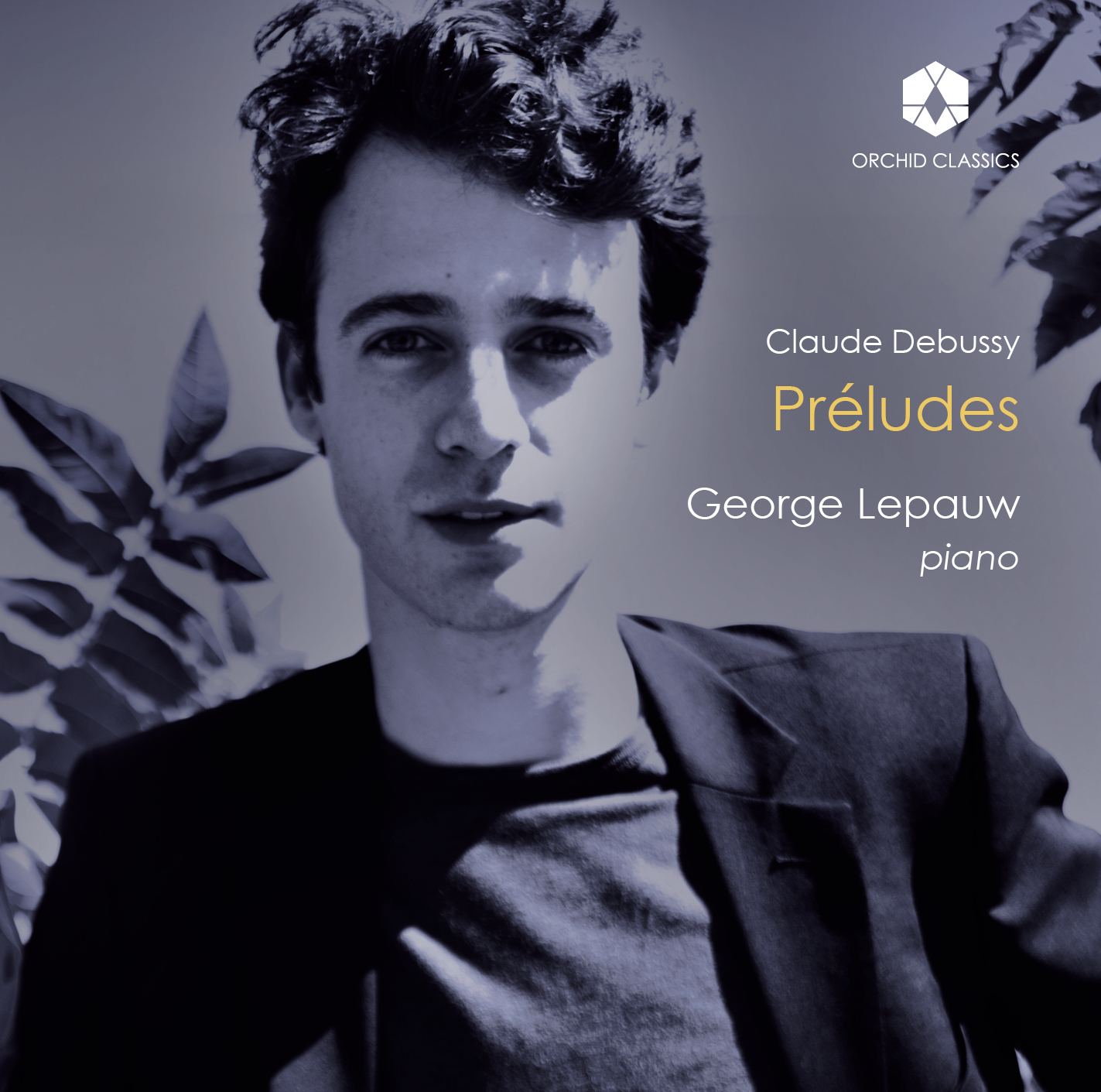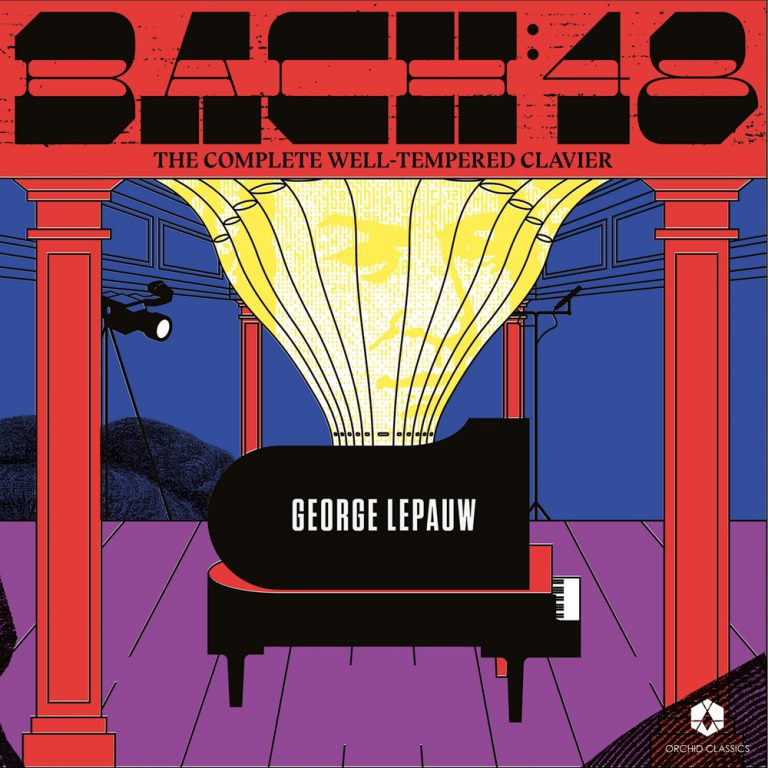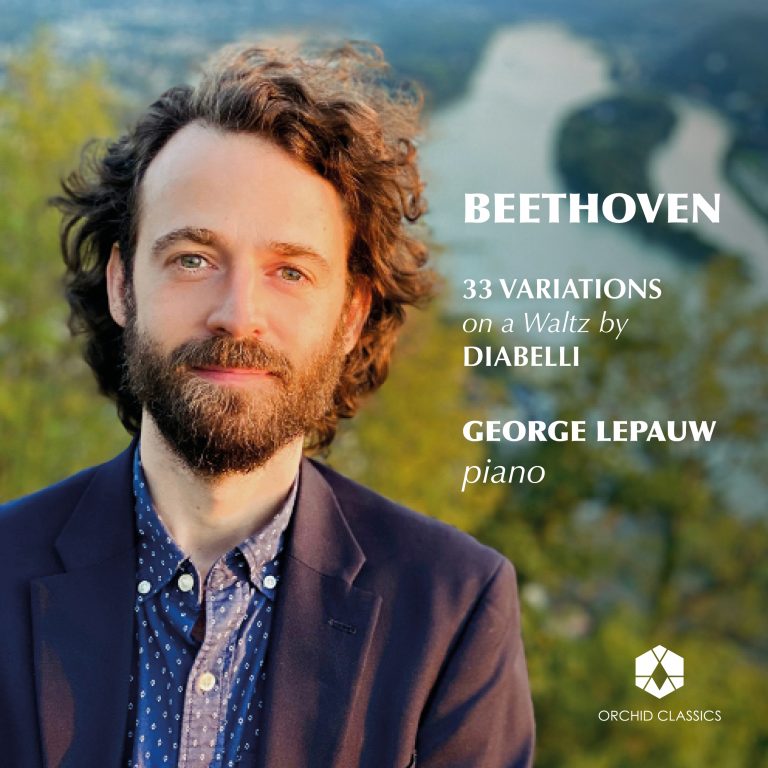Artist Led, Creatively Driven

Debussy
Preludes for piano
George Lepauw
Release Date: October 21st
ORC100205
PRÉLUDES POUR PIANO
Claude Debussy (1862-1918)
1er Livre (1910)
1. Danseuses de Delphes (Dancers of Delphi)
2 Voiles (Sails/Veils)
3. Le Vent dans la Plaine (The Wind in the Plain)
4. “Les Sons et les Parfums tournent dans l’air du soir”
(Sounds and Scents Waft in the Evening Air)
5. Les Collines d’Anacapri (The Hills of Anacapri)
6. Des pas sur la neige (Footsteps on the Snow)
7. Ce qu’a vu le vent d’Ouest (What the West Wind Saw)
8. La fille aux cheveux de lin (The Girl with the Flaxen Hair)
9. La sérénade interrompue (The Interrupted Serenade)
10. La Cathédrale engloutie (The Sunken Cathedral)
11. La danse de Puck (Puck’s Dance)
12. Minstrels
2ème Livre (1913)
13. Brouillards (Fog)
14. Feuilles mortes (Dead Leaves)
15. La puerta del Vino (The Wine Gate)
16. “Les Fées sont d’exquises danseuses”
(Fairies Are Exquisite Dancers)
17. Bruyères (Heather) 2.51
18. “Général Lavine” – excentric
19. La terrasse des audiences du clair de lune
(The Terrace of Audiences in the Moonlight)
20. Ondine
21. Hommage à S. Pickwick Esq. P.P.M.P.C
22. Canope
23. Les tierces alternées (Alternated Thirds)
24. Feux d’artifice (Fireworks)
George Lepauw, piano
George Lepauw tells the story of his debut album, released 15 years after the recording, in a blog you can read here
__________________________________
The Preludes
“[I am] a man who sees mystery in everything […]”
Claude Debussy
In his seminal book on the composer’s life and music, Debussy, His Life and Mind (London, Dent & Sons Ltd, 1980 revision) Edward Lockspeiser, who spoke with many of Debussy’s own friends and colleagues and thus knew his subject particularly well, called his hero “[…] a unique artistic phenomenon in the history of music” (Lockspeiser 162). His analysis has clearly stood the test of time.
Claude Debussy (1862-1918) was a fiercely independent composer, who like Beethoven learned all he could from past masters only to blaze ahead on his own path, always the seeker, “for like Beethoven, Debussy knew that the burden of the explorer is that the promised land is never reached, and that each discovery, miraculous as it may be, is yet another of music’s imperishable illusions” (Lockspeiser 162). He did not teach at the conservatory, was a part of no group, and left no school behind him; yet he was deeply influential to many strains of modernism to this day, over a century after his death.
The twenty-four preludes Claude Debussy composed for piano between 1909 and 1913, divided into two sets, or “books”, of twelve, are a cornerstone of his mature creative output. He had already composed most of his great and famous masterworks by the time he began working on his Préludes in 1909: Prélude à l’Après-Midi d’un Faune (1894), Pelleas et Mélisande (1902), La Mer (1905)…
In the last decade of his relatively short life (he died of cancer at 55), he let go of ambitious orchestral projects to devote his attention to smaller works for piano, such as the Préludes (1909-1913), the Etudes (1915) and En Blanc et Noir (1915, for two pianos) as well as his Six Sonatas, of which he only completed three, for two and three instruments (1915-17).
Although they stand as some of the most inventive works ever written for piano, some of which are particularly well known (The Girl with the Flaxen Hair, The Sunken Cathedral, Footsteps on the Snow, Fireworks…), most listeners are hardly aware of the Préludes as a cohesive set of two tightly wound books. Yet taken as a whole, they offer us a most wondrous trip into the sensual and colourful mind of Debussy. Again, in the words of Lockspeiser:
“In the two books of Preludes we are escorted on many novel journeys […], continuously changing as exotic images are revealed of the Orient, Spain, Italy and […] Scotland; as harsh, magnified caricatures are presented of the Victorian music-hall; as legend, prose and poetry are delineated in music; as the mysteries of nature are yet again evoked […]. Debussy shows himself in the Preludes to be as much a clairaudient as a clairvoyant. His mysterious conception of the tactile properties of music is equally remarkable, and there are pages which might almost bring music to the borders of an odoriferous […] art” (Lockspeiser 155-156).
Debussy was naturally curious and found profound musical inspiration in the exotic sounds of the Javanese Gamelan (which he discovered in 1889 at the Paris World Fair that also revealed the Eiffel Tower), in early American syncopated music (ragtime and banjo music, J.P. Sousa’s band music), as well as in images of Hokusai’s Japanese prints, in the lore of Moorish Spain, in the mysteries of Indian spirituality, in the symbolist poetry of Baudelaire, Verlaine and Mallarmé, in the 18th century of Rameau and Watteau, in the illustrations of Arthur Rackham, in the oil paintings of Turner, in the new art of cinematography, in theatre, dance and circus and of various legends and fairy tales from around the world. And all of this in addition to the personal experience the Parisian composer acquired from his many travels across Europe, from Rome to Moscow, Vienna to London with many stops in-between. Musical inspiration came easily to Debussy: “[I am] a man who sees mystery in everything […]”, he once said, and this mystery is palpable in these preludes.
His manner of composing for the piano was revolutionary. He was able to find colours in the sound production of the instrument that composers before him had never even explored. Having heard Franz Liszt (1811-1886) perform as an old man in Rome, he was struck by his use of the sustaining pedal as “a kind of breathing”. Debussy’s writing, especially in the more virtuosic preludes, is very Lisztian indeed, as well as indebted to Chopin (who had been Debussy’s first teacher’s teacher). But he went further: “[…] the piano was to be transformed into an instrument of illusion […]” (Lockspeiser 155).
He was a keen observer and listener, and it was above all the variety and beauty of the natural world, which led his inner world to flourish. In Debussy’s own words:
“The sound of the sea, the curve of the horizon, the wind in the leaves, the cry of a bird register complex impressions within us. Then, suddenly, without any deliberate consent on our part, one of these memories issues forth to express itself in the language of music. It bears its own harmony within it. By no effort of ours can we achieve anything more truthful or accurate. In this way only does a soul destined for music discover its most beautiful ideas” (in Lockspeiser 99).
Debussy’s genius is on full display in these preludes, all of which are conceptually vast, if miniature, masterpieces. The prelude as a musical form allowed Debussy the freedom he sought: he could follow his instinct without regard for any predetermined structure. Preludes have always been considered improvisatory works, used by many composers famously including Bach and Chopin (who also composed a set of 24 preludes) to let their intuition guide their fingers on the keyboard and their quill on paper. As such, they represent the quintessence of the composer’s untethered genius.
While the titles to each of Debussy’s preludes are of utmost interest and help guide the mind in its attempts to make sense of the composer’s sometimes mysterious music, it is to be noted that he placed these titles in the score not at the top of each piece, but at the end (and in parentheses!), a rather unusual place indeed. It seems that Debussy did not want words to define this music but preferred instead that these preludes live independently from their potentially constraining titles. He offers us these (sub) titles as suggestions, an approximate translation, rather than as an imposition on our minds. What was clearly important to Debussy, ever a sensual man, was that the listener experienced his music with his senses rather than his intellect.
Making the album
While I was born and raised in France, my pianistic education was mostly centred on Beethoven and Chopin. Debussy’s music was first revealed to me in his symphonic works, as my father was a member of the Orchestre de Paris and I had the privilege of hearing frequent performances of his Prélude à l’après-midi d’un faune, Nocturnes, La Mer, Images… Those powerful and enveloping sounds left their mark, but it was not until my mid-twenties and in Chicago, that I fell down the rabbit hole and wholly discovered Debussy’s two sets of preludes for myself, which shook my world. In a matter of weeks, I had learned them entirely and began performing them as concert programmes. While these works have always stayed in my fingers and repertoire, this was a period of special effusion and of still-youthful excitement at the unexpected worlds Debussy opened in my spirit. I also felt deeply connected to Debussy’s lifelong spirit of rebellion and hard-earned independence.
Debussy’s preludes also represent a breaking-of-chains from my formal musical studies, helping me to earn the mastery and the freedom I was seeking as a musician. I had just come out of music school and was yet unsure of myself. Then through happy circumstances, I was invited to spend some time with the great (and now late) American pianist Earl Wild, who was born when Debussy was alive and who, upon hearing me play these works, gave me simple but life changing advice: “Music is a dance. Go with it!” I took this to heart and let go of any mental restraints.
Less than a year later, in August 2007, I recorded the two books of Préludes in a single evening on the stage of the Music Institute of Chicago’s Nichols Hall, in front of a camera crew (for a filmed version of this recording which will see the light of day soon) and microphones. I performed all the preludes twice, straight through from start to finish. The resulting recording, a selection of the best takes from that night, is an honest portrait of the musician I was then. It retains, all these many years later, a special and unique energy. This privately organised recording would however not have been possible without the support and generosity of my parents Jane and Didier Lepauw and of my father’s initiative in setting up and managing the recording event itself, for which I am most grateful.
Each one of these preludes is a world unto itself and can easily stand alone. Listening to them individually or as part of the entire set is equally rewarding. How often has my mind gotten lost in the fine mists of Brouillards (Fog), or gone on a field trip to Spain’s Alhambra Palace in the Puerta del Vino prelude? But the closing work of the set is the one that creates both an exuberant energy along with a somewhat bitter, absinthe-like aftertaste, and its effect is greater when one has traversed all previous twenty-three preludes! Feux d’artifice (Fireworks) is surprisingly not as joyful as one might expect, with the closing melodic allusion to the French national anthem, La Marseillaise, seeming more of a seer’s foreboding of coming tragedy than a display of triumph. Published in 1913, Debussy could hardly have known of the imminent killing fields and mustard gas-filled trenches of La Grande Guerre (The Great War). Yet, how can we not, now in retrospect, hear the tragedy of unfettered patriotism in these wafting sounds of a bygone era? Or could it be a warning to us in our own time? I certainly believe this music remains essential to this day and contains eternal insights for humanity.
You can join me in exploring these preludes and Debussy’s world with further information on our dedicated website:
George Lepauw is a Franco-American pianist based in Paris, France. His recent Bach48 Album of the complete Well-Tempered Clavier by J.S. Bach on Orchid Classics has earned wide praise from critics and audiences alike and his upcoming traversal of major Beethoven works including the 32 Piano Sonatas and several variation sets will be released in the coming years. An album of rare Beethoven piano trios was also released on the Cedille Records label as part of the Beethoven Project Trio in 2010. George Lepauw’s teachers have included Aïda Barenboim, Elena Varvarova, Brigitte Engerer, Rena Shereshevskaya, Vladimir Krainev, James Giles, Ursula Oppens and Earl Wild. He has been additionally mentored and supported by Carlo-Maria Giulini, Maria Curcio, and Charles Rosen. He holds degrees in History and Literature from Georgetown University and in Piano Performance from Northwestern University. George Lepauw was named Chicagoan of the Year in 2012 by the Chicago Tribune for his visionary artistic leadership in music, art and film festival programming, has been recognized by the New York Times for his “singing tone” and by the Chicago Tribune as a “prodigious pianist”. Concurrently to his performing and recording career, George Lepauw teaches piano, composes music, produces music films and writes articles about music.
Follow George Lepauw’s musical journey at www.georgelepauw.com









